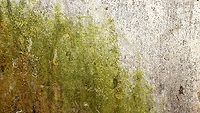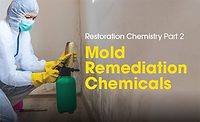Mycotoxin Control as a Critical Part of Mold Remediation
The risk of exposure to poisonous chemicals

Photo credit: PoultryGraphics / iStock / Getty Images Plus via Getty Images
Mycotoxin is the technical term for poisonous chemicals produced by fungi (mold, mushrooms, mildew, etc.). The purpose of the mycotoxins is to protect the food source for the fungi. Since many molds grow slowly as compared to bacteria and other microorganisms typically found in water-damaged buildings, the production of poisons kills off many of the other competitors.
A Documented Danger to People
In addition to protecting their colony from other organisms trying to utilize the same food source, mycotoxins are also produced to protect the mold colony from destruction by insects or animals that otherwise might find the fungi tasty (blue cheese or mushrooms for dinner, anyone?).
So it stands to reason that if this toxic defense mechanism is designed to disrupt biological processes in other living things, these chemicals would also be dangerous to humans.
Unfortunately, at this point, most of the scientific information that we have about mycotoxins comes from the agricultural side of things. Mycotoxins are regulated in our foodstuffs, but their presence in indoor environments as a result of water damage and mold have not been widely studied. The damage that fungal growth, and their associated mycotoxins, does to animals and people that eat contaminated foods is well-documented. The World Health Organization (WHO) puts it bluntly:
Mycotoxins can cause a variety of adverse health effects and pose a serious health threat to both humans and livestock.
What Is The Risk If Mycotoxin Exposure Is From Inhalation Rather Than Ingestion?
The physical make-up of mycotoxins is such that the poisons are generally sticky and are non-volatile (i.e., do not easily evaporate at room temperature). These factors are what led many researchers down the wrong path of thinking that mycotoxins did not go airborne very easily. However, in just the last few years, two different sampling methodologies were brought to the restoration market which allows for the identification of mycotoxins in the air.1
The growing body of sample results from these new technologies, and continued research, has shown that mycotoxins are quite easily aerosolized even after the poisons are stuck on surfaces. Indeed, detailed testing has proven that air speeds typically produced by residential HVAC systems and occupant movement can aerosolize mycotoxins. These discoveries proved that mycotoxins on surfaces soon contaminate the settled dust, and then get picked up by the air, which migrates the poisons to all areas of the structure.
A very scary aspect of the recent research on mycotoxins is that the chemicals that go airborne typically attach to particles that are smaller than 3 µ in size. This means that the contaminants can be inhaled deep into the respiratory system. Worse yet, some of the mycotoxin contaminated air does not make it to the lungs but, instead, lodges in the nasal passage. From there the poisons can migrate quickly to the brain. Nor is this just speculation; at least one study has shown this poison exposure pathway has been confirmed in animals.
What Does All This Mean For Contractors?
From a removal standpoint, several factors are critical to keep in mind:
- A structure that has water damage and mold growth has mycotoxin contamination.
- Mycotoxin contamination generally spreads well beyond the area of source contamination.
- Mycotoxins cling to dust particles smaller than what are typically trapped by HVAC filters; meaning that the mechanical system is compromised.
- Occupants, particularly mold sensitized occupants, can suffer acute and often compounding negative health effects from exposure to even a small amount of mycotoxins.
- The released mycotoxins are not easily destroyed, are not broken down by water, and do not absorb water.
- The standard HEPA sandwich approach to mold cleaning of surfaces often is not effective in removing mycotoxins.
- The revised process known as a HEPA pizza, where the second HEPA vacuuming is replaced with a wipe down using disposable microfiber cloths, has shown real promise in controlling mycotoxin contamination.
- Few of the standard remediation cleaning chemicals have been specifically tested against mycotoxins to prove that they are effective at removing the mold poisons.
- One product that has been tested and shown to remove those chemicals is the hypochlorous acid cleaner from Superstratum.2
- Standard mold remediation techniques often require an expanded scope of work that includes cleaning surfaces outside of a work enclosure and contents.
- Additional steps to address residual mycotoxins that have migrated to inaccessible areas may also be helpful.
- Given anecdotal evidence regarding its effectiveness, plans are underway to test treatment of structures with controlled release chlorine dioxide gas as a means of eliminating residual mycotoxins.
A Specific Plan for Mycotoxin Removal
Taking all of the factors discussed in the previous section into consideration, a mycotoxin cleaning process has been developed by the professionals at Superstratum. The steps recommended following the controlled removal of the mold source material are:
- Initial testing to confirm the presence of mycotoxins in the environment.
- Initial fog treatment of the entire structure with Superstratum Hypochlorous Acid Pro Cleaner.
- Detailed cleaning of all surfaces in the structure using Superstratum Hypochlorous Acid Pro Cleaner.
- Second fogging of the structure with a diluted solution of Superstratum Hypochlorous Acid Pro Cleaner.
- Gas phase treatment of the structure with chlorine dioxide.
- HEPA Filtered MCI (multi-cluster ionization) Positive Air Flush.
- Application of Superstratum Smart Polymer Coating to mold-prone surfaces in the structure.
- Post cleaning and treatment testing for mycotoxins to assure the effectiveness of the process.
More Information Is Available
With all the interest and ongoing research in mycotoxins, there is a large body of information that restoration contractors have available. But, too much information can be as difficult to deal with as is too little. To assist mold contractors to come up to speed quickly, a detailed whitepaper entitled Understanding And Dealing With Mycotoxins has been painstakingly developed. It is real science and fully referenced with over 25 specific citations to published papers. The best news is that the white paper is available for free. It can be found at the Wonder Makers’ website.
Footnotes
- The two commercially available, and easy to use, sampling methods that can detect mycotoxins in the air include a system called AirAnswers and a sampling process developed by Respirare Laboratory. The AirAnswers device uses electrokinetic capture technology to adhere mycotoxins to a stainless-steel cartridge for later laboratory retrieval and analysis. In contrast, the Respirare Laboratory approach draws air through a filter in a holder to capture the mycotoxins. The lab then uses a proprietary system to extract a high percentage of the poisons for analysis. Both organizations use quantitative polymerase chain reaction (qPCR) techniques for the actual analysis.
- Superstratum recently engaged Wonder Makers Environmental to test the effectiveness of their Hypochlorous Acid Pro Cleaner. The practical science test was designed to answer a simple question frequently asked in the mold remediation industry: "Is there a cleaning product that removes mycotoxins from surfaces?" As such, a piece of oriented strand board (OSB) was chosen as the surface for the testing because it is a common building material that is difficult to clean. After intentionally contaminating the OSB with a mix of mycotoxins, the surface was cleaned according to the label directions. The test results showed an overall reduction in mycotoxins on the difficult to clean OSB boards of 94% - 95%.
Looking for a reprint of this article?
From high-res PDFs to custom plaques, order your copy today!







